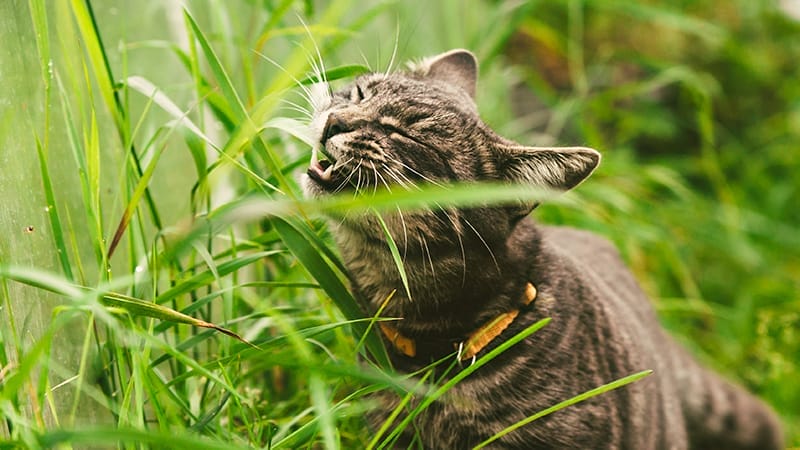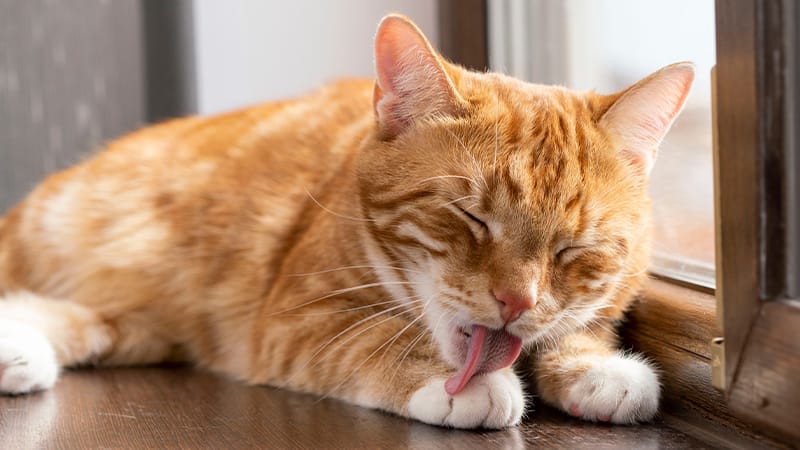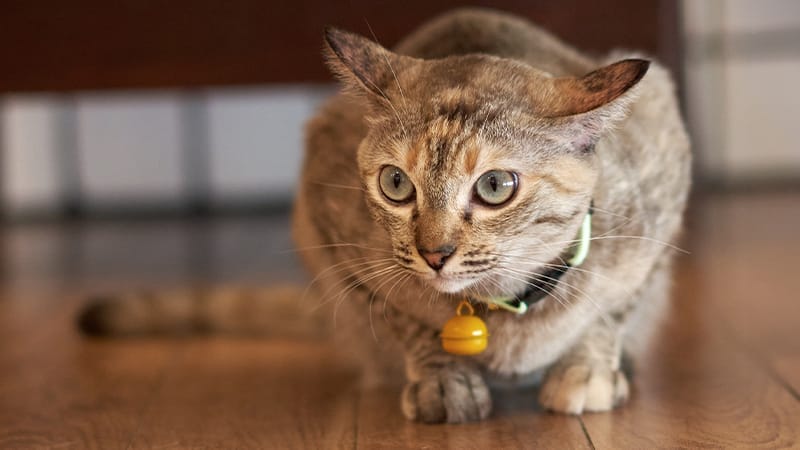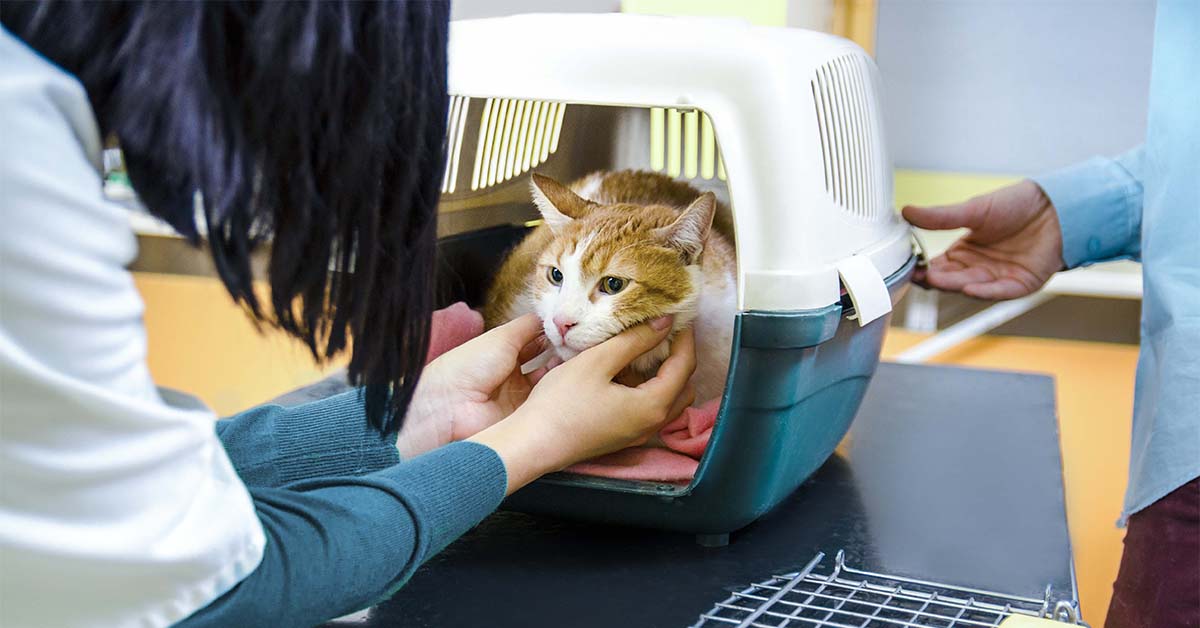Decoding Common Cat Behavior: Insights into Feline Actions and Their Meanings
Understanding your cat's behaviors is vital for a strong relationship and detecting health concerns.
Cats are mysterious creatures with a unique set of behaviors that can sometimes leave pet owners puzzled. By decoding these behaviors, we can deepen our bond with our cats and provide them with the care they need. If you’ve wondered why your cat does some of the things it does, read on as our MedVet team decodes what some common cat behaviors mean.
Physical Behaviors in Cats
Napping
Although domestic cats no longer need to hunt for survival like their ancestors, their genetic makeup still influences their behavior. One such behavior is their inclination to conserve energy through frequent napping. Cats have a slightly higher basal temperature than humans, and they are naturally drawn to warm areas for their slumber, so you’ll often find them basking in the sun or curling up on warm surfaces.
Eating Grass
Cats commonly nibble on grass – but why? There are a few reasons behind this behavior. For some cats, eating grass can help with digestion by acting as a natural laxative and aiding in the elimination of hairballs. For others, it may simply be a snack or a way to fulfill their natural instinct to chew. Grass also contains essential nutrients that may be lacking in their diet, making it a valuable source of vitamins and minerals. However, it is important to ensure that the grass your cat has access to is free from pesticides or harmful chemicals as these can be toxic to felines.

Attacking People or Other Pets
Aggression in cats can stem from various factors, including anxiety or fear, territorial instincts, or feeling threatened. Providing a safe and enriched environment, along with positive reinforcement training, can help reduce aggressive tendencies in cats.
Knocking Things Over
Cats have an inherent curiosity about their surroundings and often engage in exploratory behavior by using their paws to touch and interact with objects. This is why you may observe them “batting” or pushing items around. When an object rolls or moves in response to their touch, cats may perceive it as prey trying to escape, triggering their instinct to chase. This playful behavior allows them to satisfy their natural hunting instincts and provides mental and physical stimulation.
Bringing Items to You
Cats have an innate hunting instinct, which can sometimes manifest in them bringing their humans dead birds, rodents, or bugs. This behavior is a way for cats to show their affection and regard their human family as part of their pack. By presenting these items as gifts, cats are demonstrating their desire to contribute to the group’s wellbeing and ensure that their humans are well-fed. This behavior may also be influenced by their early experiences as kittens, when their mother would provide them with food and teach them hunting skills.
Urinating Outside the Litter Box
Urinating outside the litter box or on the bed can be a frustrating behavior for pet owners. Cats may engage in this behavior due to stress or a dislike for their litter box. Ensure your cat has a clean litter box and provide them with multiple litter boxes in different locations to address any stressors.
Medical issues can cause difficulty for your cat to urinate appropriately. MedVet often treats cats for urethral obstruction, a life-threatening blockage of the lower portion of the urinary tract. The condition is generally caused by urethral plugs, stones, tumors, or strictures. If your cat has increased vocalization, is frequenting the litter box more often, strains while urinating, or licks their hind end more than usual, consult your veterinarian to rule out any underlying medical issues.
Scratching
Cats engage in scratching behavior for several reasons. Scratching helps them maintain the health of their claws by removing the outer sheath and keeping them sharp. Additionally, scratching allows cats to stretch their muscles and maintain their flexibility. It also serves as a way for them to mark their territory, as they leave both visual and scent marks through the glands in their paws.
To prevent your cat from scratching furniture or other undesirable surfaces, it’s important to provide them with appropriate scratching posts or boards. These should be sturdy, tall enough for the cat to fully stretch, and covered in a material that mimics the texture of tree bark or sisal rope. Placing the scratching post near the furniture they tend to scratch can help redirect their behavior.
Regular nail trims can also be beneficial in managing your cat’s scratching habits. By keeping their nails trimmed, you can reduce the damage caused by scratching.
Zooming
The infamous “zoomies” refer to sudden bursts of energy when cats sprint around the house, often accompanied by playful antics. This behavior is completely normal and is a way for cats to release pent-up energy.
To help channel their energy in a positive way, provide interactive playtime with toys that mimic prey, such as feather wands or laser pointers. Engaging in play sessions with your cat can help tire them out and provide mental stimulation while reducing the frequency and intensity of the zoomies.
Self-Care Behaviors in Cats
Grooming and Licking
Cats groom themselves to maintain cleanliness, reducing the need for bathing and grooming. They also lick humans to show affection and bond. Normally, they pass the hair they consume from grooming. However, excessive grooming may indicate stress or medical issues and can cause them to have a buildup of hair in their gastrointestinal tract, commonly referred to as a hairball. Once the hairball soaks up enough bile, it triggers a regurgitation response. The gagging, hacking, or retching sounds that often lead to vomiting are unmistakable to most. If these behaviors are prolonged and/or accompanied by lack of appetite, lethargy, constipation, or diarrhea, a hairball could be causing a potentially life-threatening blockage. Call your family veterinarian right away or bring your cat to MedVet.

Vocal Behaviors in Cats
Purring, Meowing, and Hissing
Cats use vocal sounds to communicate their needs and emotions. They have a wide range of vocalizations, from meowing to hissing, growling, purring, and chirping. Meowing is often a form of communication with humans, while hissing and growling indicate fear or aggression. Purring is generally a sign of contentment, but it can also indicate pain or stress. Understanding these vocal cues can help you better respond to your cat’s needs.
Night Squalling
Cats primarily squall at night because of their natural instinct to mate. When cats are in heat (also known as estrus), they call out to attract potential mates, and this vocalization can be quite loud and persistent.
Cats may also squall at night because they realize their vocalization gets them attention and care, like receiving a snack or petting from their owners. They may develop a habit of squalling to get what they want.
To minimize night squalling, keep your cat indoors to reduce their exposure to potential mating partners. You can also create a restful bedroom environment with a nightlight and calming scents like lavender to promote a more restful sleep for both you and your cat.
However, there can also be medical reasons behind a cat’s nighttime squalling. Older cats with decreased vision or hearing may seek reassurance from their owners during the night. Cats with health issues such as hyperthyroidism, hypertension, hypokalemia, thiamine deficiency, or intracranial masses may also vocalize at night. If you’re concerned your cat’s nighttime squalling may be due to a medical issue, contact your family veterinarian for guidance.
Body Language Behaviors in Cats
Kneading
Kneading is a common behavior in cats where they rhythmically push their paws against a soft surface. It signifies contentment, relaxation, and stems from their kittenhood when they stimulated milk flow from their mother’s mammary glands. It can also be a sign of affection and territorial marking through scent glands in their paws.
Head Bunting and Rubbing
When your cat rubs its head against you or objects in your home, it’s a display of affection and marking territory. Cats have scent glands on their heads, and by head bunting or rubbing, they are leaving their scent as a way of claiming ownership and showing love.

Ear and Tail Movement
Cats have highly expressive ears that can provide valuable insights into their mood and intentions. When a cat’s ears are pointed forward, it usually indicates attentiveness and curiosity. They may be focused on something in their environment or preparing to pounce. On the other hand, flattened or backward ears can be a sign of fear, aggression, or discomfort. Your cat’s tail also serves as a means of communication, conveying a wide range of emotions. A relaxed, gently swaying tail indicates contentment and relaxation, while an upright, puffed-up tail signifies aggression or fear. A flicking or twitching tail may indicate excitement or anticipation.

Knowing When Your Cat is in Pain
It can be challenging to know when your cat is in pain because they are good at hiding it. If your cat is behaving differently than they normally do, such as inappropriate toileting, aggression, self-mutilation, or other uncharacteristic behaviors, they may be in pain. If you think your pet is in pain, contact your family veterinarian.
Understanding your cat’s behaviors is key to building a strong and harmonious relationship. By decoding their actions, you can better respond to their needs, provide appropriate care, and create a nurturing environment. Remember, each cat is unique, and their behaviors may vary. Pay attention to their body language, vocalizations, and overall demeanor to gain insights into their emotions and wellbeing. Enjoy the journey of understanding and connecting with your feline friend!
Discover exceptional emergency and specialty veterinary care at a MedVet near you.
FAQs
Contents



